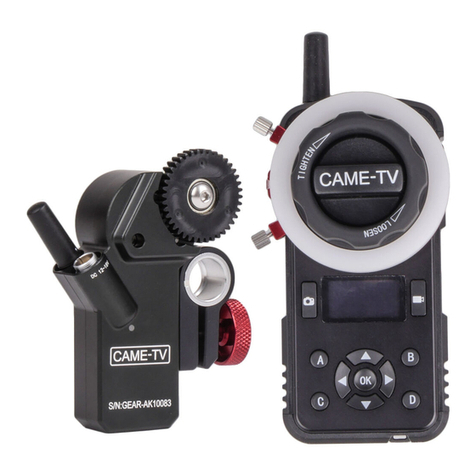Thank you for purchasing the CAME-TV Single. Please read this manual and disclaimer carefully before
commencing use. By using this product, you hereby agree to this disclaimer and signify that you have read it
in full. You agree that you are responsible for your own conduct and any content created while using this
product, and for any consequence thereof. You agree to use this product only for purposes that are proper and
in accordance with local regulations, terms and any applicable polices and guidelines.
Do not modify or adjust the CAME-Single’s electronic programming through rmware upgrades or software
alterations. Doing so without direct guidance or permission from CAME-TV personnel can cause malfunc-
tion to your gimbal and can jeopardize your warranty. The CAME- Single has been calibrated before it
leaves the factory. No modication or amendment to the CAME-Single is allowed or needed.
As CAME- TV has no control over customer use, setup, nal assembly, modication or misuse, no liability shall
be assumed nor accepted for any resulting damage or injury. By the act of use, setup or assembly, the user
accepts all resulting liability. CAME- TV assumes no liability for damage(s) or injuries incurred directly or
indirectly from the use of this product.
Any part of this disclaimer is subject to change without prior notice.
Please contact us if you have any question or problem regarding the proper use of this product.
More information can be found at http://www .cametvblog.com/category/faq
320
195
186
(Unit:mm)
Roll Motor
Yaw motor
Pitch Motor
52.5
86.5
1
Disclaimers and Warnings
1 click is follow yaw and follow tilt mode.
2 clicks is follow yaw and lock tilt mode.
3 clicks s lock yaw and lock tilt mode (No follow movements).
The Single comes already programmed with 3 pre-set factory modes. Simply follow the instructions below to
toggle between them. (Note: An audible chime after button press will conrm mode change)
Maintenance
3. Functions Introduction
4. How to use the Single’s working mode button
8
The CAME- Single is a precise machine and it is not water resistant. Keep it away from sand and dust during
usage. After use, it is recommended to wipe the CAME- Single down with a soft dry cloth. Never spray any
cleaning liquids onto the CAME- Single.
[1]Joystick for direction control
[4] USB Connector
[7]Power on/o
P8
[6]mode switching
(For the PID and software changes)
[2] Battery Indicator
Green--full battery
Yellow--Alert power enough
Red-- Need urgent charge
(The power switch is also the battery power switch\
long press for 3 seconds and the gimbal power will
turn on or o)
Slide the button (Up,down, left ,right)
to control the gimbal’s pan & tilt
movements.
U
D
下
LR
[3]Signal light
(Blue light “ON” when power on)
Camera Size Requirements:
The maximum depth from the center of
gravity on the camera base plate is
86.5mm.
the maximum width from the center of
gravity to the pitch axis is 52.5mm.
Camera and Lens should be within 1Kg.
[5]1/4 screw hole
( for external magic arm to support monitor
or other device)
1/4 screw hole3/8 screw hole
( Bottom of gimbal handle)
























